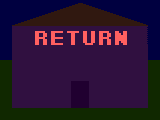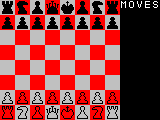
How does the game, ten, work and how do you play?
1. Ten's basics
If you'd like to know this game's history and how I developed it, read this.
Ten is one of my many math games I have, only this game is the most basic at it's easiest. Even a two-year-old can play this game, as long as he/she knows how to count to ten and separate ten from something.
The image above shows you exactly what the game Ten is like. Why is it called ten? Many reasons:
- Your objective is to grab ten of the same small object between four fingers. You can have anything from 8 to 20. Outside these, there are penalties, which are described later.
- The reserve's limit is ten, if you go over, you need to create a new row as illustrated in the third row. If you get an even ten, that row is removed and you score points [ten]. More on this later.
- In the stock, the coins are stacked ten high in ten rows and ten columns.
I think you get the point now, ten, ten, everything ten! That's why I call the game... Ten. [How many times has the word been used? Seems like ten is likely.]
2. How to play
Equipment/items required
At least 200 small objects resembling a coin [may be poker chips, actual coins, just about anything no bigger than 1 inch around [25 millimeters]; in this game, "coins" are used as the objects, particularly pennies as I have several thousand of them], however, if you wish to get a big stock, 500 or more is recommended, but not neccessary. I've actually played with well more than 1800....
1 pencil or pen
1 piece of paper [preferrably lined so help line up things, but not necessary].
1 table or floor to put the stock and reserved items on.
1 container, especially one where you can easily get into like a small, short box, a bowl, etc., to store your coins.
Setup
Place all of your small objects in the container. Clear enough space to place your stock and reserve.
Rules of play
Basic rules
With only four fingers [does not include the smallest finger], grab a group of pennies that you feel is pretty close to ten. If you hold them for longer than 4 seconds, you must drop all of your coins and grab another bunch. If you feel as if you have too few, you can drop all of them and try again. If you feel as if you have too many [up to 20 is the limit], you can slowly drop some into the container, but you still cannot hold them for more than 4 seconds. Once you feel as if you have an adequate amount, preferrably, aim for about 12 coins as it's good to go over ten. At first, you must go over 10, otherwise you end up with a negative score. Scoring is explained later.
After you feel as if you got a good amount, take your hand out of the container while holding your coins, upon doing so, the 4-second limit expires and is no longer in place. However, you cannot return the coins, except if you get less than 8 [a penalty] or more than 20 [a huge penalty]. In the image above, you've grabbed 12, a decent start. Separate ten from this group of 12 and place the remaining two in your reserve while adding your separated ten to the main stock. After doing so, take out another hand given the same rules as before and continue until your container runs close to empty [like less than 30 coins typically].
Main game rules
Including the basic rules, you continuously take out some coins from the container separating ten and placing them in the reserve. Here's some if statements to consider:
- If, when you separate ten from your hand, the extras goes over the maximum of ten in all rows in the reserve, start a new row directly below it [or in a decent enough area either above or below].
- If the extras make an exact match of ten, you score points and the whole row is removed and added to the stock [thus making two stacks of ten instead of the usual 1].
- If two or more rows can take the amount you have extra, choose one of those rows to eliminate, but keep the other.
- If a full row of ten in your main stock comes [100 counted], start a new row directly below it.
- If ten rows exist in your stock [1000 counted], start a new square spaced somewhat away from the first group of ten.
- If, when you have ten thousand items, your ten squares become, start a new column or row beside it spaced somewhat like that of a new block of 1000.
Seem simple? Even the scoring is fairly simple.
3. Scoring
There are numerous ways for scoring. Here are all of them:
- You score ten points for every hand you go through.
- You score ten points for each occasion in which you remove a row times the number of rows you have [i.e. you have 3 non-five rows and clear one making it 2, you score 30 points as 10×3 is 30.
- You score twenty points if you get exactly ten in your hand.
- You score eighty points if you get exactly twenty in your hand times the number of rows you have minus 1. [i.e. you have 3 non-five rows, dealt out 20 coins, you'd score 80×(3-1), or 80×2, or 160 points. If you have only one row, you score 50 points instead of 80 [or zero]. If you have no rows at all, you score 250 points, a big one.
- If you have an occasion in which you can choose a row to eliminate as they both could be with your hand, you score ten points for clearing that row, plus 5 extra for the second row that can take it, 20 points for the third row, and 80 points for the fourth row.
- If you get 8 or 9 in your hand, you can remove 1 or 2 accordingly from your reserve from any row you want. If this causes you to empty a row, you score the usual ten points, plus ten more.
- If you have a small row [typically 1 to 4] and get what would be the equivelent of a non-five row, but end up making ten, you score ten points for the ten taken out of your hand and ten more for each coin extra. [i.e. have a row with only 3, and you get 17 in your hand, you score the ten for the hand plus ten for the row plus another 7×10 or 70 for the special occasion giving you a total of 90 points in all!]
A non-five row is any row with a set group of 6, 7, 8, or 9 in them, caused from getting 16 to 19 coins in your hand. Getting three of these calls for a big penalty.
There are many penalties as well, far worse than what you could get with scoring. Here are all of them:
- If you hold on to the coins for longer than four seconds and take that as your hand, you lose 25 points plus the number you got. [i.e. if you held them for 6 seconds, took that as your hand without replacing them, and had 10 coins, you'd lose 35 points] If you put them back after viewing them and not knowing your number, you lose a total of 50 points.
- If you grab less than 8 coins, you lose ten points.
- If you grab more than 20 coins, you lose 50 points times the number of rows you have. [i.e. you have 3 rows, you'd lose 150 points for this].
- If you have 2 non-five rows and get another, you lose 100 points and 50 more for each five-row you have, a devistating impact [i.e. 3 non-five rows and 2 five-rows would cause a loss of 200 points because 100+(50×2)=100+100=200]. Also, if this occurs, that extra non-five row gets placed back in your container along with all other rows you currently have. This is very devistating, so avoid getting more than 1. If you do get one, try to aim low like around 9 to 11 coins.
- If a row is given more than ten without creating a new one [you have an unlimited number of rows you can create], it's a 20 point penalty for each coin extra and that row is to be removed and placed back in your container.
4. The game's end
When your container gets to almost nothing, the 4-second timer is removed. However, you cannot look at what you're grabbing. Here's the only case in which you may actually count before you consider your hand. You may not count more than 15, and, as usual, less than 8. Use this to help clear up the extras in the reserves for a special bonus. If you're playing for fun instead of counting, when you're low on coins [like less than 30 remaining], you may move all coins in the stock and place them in your container to continue. In the "for fun" version, when you get low, the 4-second timer doesn't expire and you cannot count the coins, rather, you must take them as a normal round.
That's all there is to playing the game Ten. Now, let's count how many times the word and name "ten" have been used. Ready for a round or two [or ten] to count them?
Footnotes:
* FYI: The word and name "ten" including this one appears 50 times in the entire rules report alone, not including the history!






